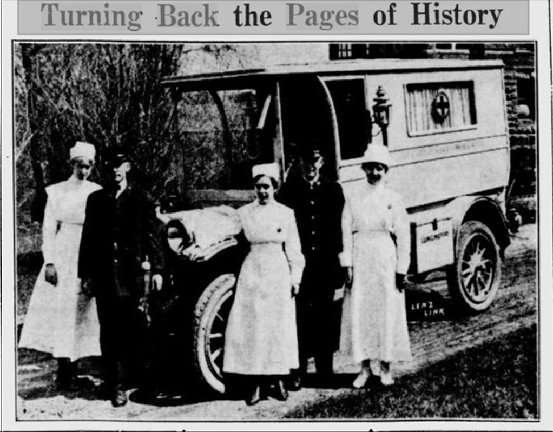Encyclopedia Dubuque
"Encyclopedia Dubuque is the online authority for all things Dubuque, written by the people who know the city best.”
Marshall Cohen—researcher and producer, CNN
Affiliated with the Local History Network of the State Historical Society of Iowa, and the Iowa Museum Association.
AMBULANCE SERVICE: Difference between revisions
(Created page with "This entry is being edited. left|thumb|250px|Telegraph Herald, June 28, 1936. Image courtesy: Diane Harris AMBULANCE SERVICE. The first ambulance in t...") |
(No difference)
|
Revision as of 20:15, 30 May 2014
This entry is being edited.
AMBULANCE SERVICE. The first ambulance in the city of Dubuque was a horse-drawn vehicle donated to FINLEY HOSPITAL (THE) by Fannie STOUT. The problem with it was that customers had to hire horses from the Nutwood livery stable, owned by the Stouts. (1)
In 1916 the city decided to buy its own rig after a man whose legs had been run over by a train had to lay a long time waiting for service. According to the story, the ambulance driver wanted his cash first before starting out. (2) The ambulance service of the city which was free turned out to be something of a taxi service, so a charge of two dollars was made for its use. This was later raised to four dollars. (3)
The first ambulance driver was responsible twenty-four hours daily and three hundred sixty-five days annually. He ate and slept at the 9th Street firehouse, so his supervising offer changed from the chief of police to the fire chief. Although some of the undertakers and hospitals operated their own ambulances, the city responded to ninety-six percent of the cases. The job quickly developed into a two-man operation. (4) In 1954 the two men--Howard Lent and Cyril Behr--had held their jobs of nine and eleven years respectively. (5)
In 1954 the 1951 vehicle used was considered a great improvement. The back could carry three persons lying flat on the roller stretcher and two portable cots. The new two-way radio meant that emergency calls could be received while on another accident. In the past, such calls to the firehouse had to wait until the ambulance returned. The per capita cost for twenty-four hour service in 1954 was eight cents annually. (6)
In 1960 Dubuque was the only city in Iowa of its size with a city owned and operated ambulance service. Ambulance service cost the city $10,943.44 with income from call charges being $6,927. (7) People needing an ambulance from any point to a doctor or hospital paid $8.00 with the same charge being made to return the person to their home. Calls outside the city (limited to the county in Iowa) were $15.00 plus twenty-five cents per mile outside the city limits. In addition there was a delay charge of $10.00 per hour or any part thereof for delays over ten minutes not caused by the ambulance driver. (8) Contracts had been signed to provide ambulance service in Jo Daviess County and East Dubuque. The only free ambulance service was given to Dubuque city employees injured on the job. If the call was not an emergency, the driver could collect charges in advance. In emergencies, the person was billed later. (9) Ambulance service was financed from the Public Safety fund. The budget item was expected to rise in 1960 because the city had just received a new ambulance costing $7,529. The old ambulance had been retired after nine years and 75,000. (10) The same drivers were still working.
If a second call came in when the ambulance was on an assignment, the call would be responded to with the city police station wagon which was equipped with an ambulance stretcher. In 1959 the ambulance made 1,304 calls with most requiring the transfer of patients to and from hospitals. (11)
The City of Dubuque received a new ambulance in January, 1970 as a gift from the William S. Sheppley Foundation. The new ambulance could carry one patient and two attendants in the back and was air-conditioned. It also had an outlet for oxygen resuscitation and the capacity to carry at least twice as much oxygen as the older vehicle which became a backup. (12) A new city ordinance provided that when a second ambulance request was received it would be answered by Dubuque firemen in the second ambulance. The second call, however, would only be responded to if it came from within the City of Dubuque. (13)
In March, 1970 the operators of all Dubuque funeral homes announced the end of their own local ambulance service. They cited increased state and federal requirements as reasons why the service was no longer financially possible. In cases where patients had to be transported to out-of-town medical facilities, several of the funeral homes would continue to provide service allowing the city to maintain two ambulances locally. (14)
---
Source:
1. Stevens, Dave. "City Ambulance Costs Only 8 Cents a Year," Telegraph Herald, August 29, 1954
2. Ibid.
3. Ibid.
4. Ibid.
5. Ibid.
6. Ibid.
7. "City Ambulance Service Unique in Iowa," Telegraph Herald, June 26, 1960
8. Ibid.
9. Ibid.
10. Ibid.
11. Ibid.
12. "A Gift for Dubuquers: A Brand New Ambulance," January 30, 1970, p. 15
13. Ibid.
14. "Funeral Homes Ending City Ambulance Service," Telegraph Herald, March 4, 1970, p. 6


